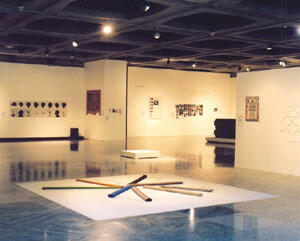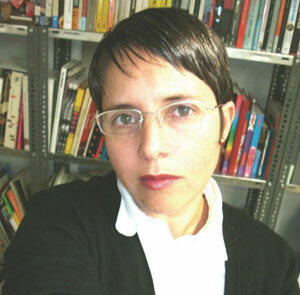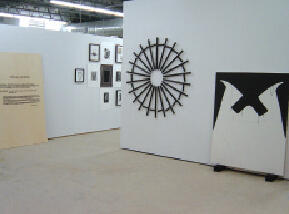PROFILE: Julieta González
A Curator’s Profile
In January 2009, the Venezuelan Julieta González accepted the challenge of being associative curator of Latin American art at Tate Modern, one of the four international museums (the others are MoMA, New York; Museum of Fine Arts, Houston; and The Blanton Museum of Art, Austin) that host Latin American art in their collections.

Her instinct, forged at the Whitney Museum Independent Study Program, the Museum of Fine Arts and the Alejandro Otero Museum in Caracas, as head of Espacio1414-Colección Berezdivin, Puerto Rico, and through special curatorial tasks for biennials such as the Prague, Lyon and Caribbean biennials, will broaden the horizon of the artistic production of the region of the past forty years, on which González will focus in order to continue the task initiated by the first curator of the collection, the Mexican researcher, critic and curator, Cuauhtémoc Medina.
Ms. González will tour the region with the mission of finding opportunities to critically reassess and contextualize the work of Latin American creators in a global ambit, yet always guided by the premise that the Tate Collection looks towards the past from the present.
What led you to specialize as a contemporary art curator?
Initially, I studied Architecture, but I was always more interested in the history and the theory of architecture than in the practice of the profession as such. I was concerned with subjects closely related to architecture, such as utopia, which I have later addressed on several occasions in my exhibits. However, I think I discovered my vocation when I was studying in Paris and I attended a Joseph Beuys exhibition at the Georges Pompidou Center. Faced with the complexities of an oeuvre such as Beuys’s and the way in which it was exhibited, I understood that was what I wanted to do in my professional life: to be a mediator between the work and the spectator, and to work with the art of my time, precisely because a purely aesthetic or formal approach to it is difficult to attain.
What aspects of contemporary art are you most interested in investigating and showing?
When I returned to Caracas in 1999, I began to work at the Museum of Fine Arts, in an exhibition focusing on the site-specific entitled “Interventions in Space”, which included works by artists such as Luis Camnitzer, Dan Graham and Joseph Kosuth. It was a privilege for me to work in that exhibition, and to do so very closely with Dan Graham and Joseph Kosuth. I think this deeply marked the line of work I would follow in the future. Then I curated a Cindy Sherman retrospective; it was my first curatorial assignment, and it also allowed me to further pursue my interest in photography. There are certain subjects that interest me more than others, as is only normal; in my particular case, these subjects are, broadly speaking, the allegorical capacity of photography and its role in Post-modern art; the city and urban dynamics; utopia; the museum and its mode of representation; and the ethnographic gaze. These issues may appear disparate, but there are meeting-points. My experience in the curatorial section of the Whitney Program enabled me to find links between these apparently unconnected interests.
As a researcher and curator, what are the unexplored opportunities and fields you have identified in relation to Latin American art?
To envisage Latin American art monolithically as an isolated construction is one thing, but to exhibit it is quite a different thing. With regard to this second aspect, I am interested in a more plural vision, one that contextualizes Latin American art beyond its geographic borders. I am not interested in regionalist visions; much less in stereotypes. While it is true that I have occasionally tried to inquire into some ways of critically categorizing the artistic production of our continent, as in the specific case of my exhibition, ‘Ethnography instructions for use: archaeology, fine arts, ethnography and miscellanea’ (MFA, Caracas, 2002), I have always done so from that wider perspective.
How do you relate your vision of Latin American art with that of other curators, such as Luis Pérez Oramas y Mari Carmen Ramírez?
I would not dare compare myself to professionals of the stature of Mari Carmen Ramírez and Luis Enrique Pérez Oramas, whose breadth of experience is so much greater than mine. But I must say that they are fundamental references for me and that I share many of their ideas about Latin American art, above all the historical approach based on an in-depth analysis of the political, social, economic and cultural circumstances under which such art was produced. For instance, Pérez Oramas’s book, La Cocina de Jurassic Park y otros ensayos visuales (Jurassic Park’s Kitchen and Other Visual Essays), has been a fundamental text for me, since it has been the first book in Venezuela that analyzes twentieth-century Venezuelan art from that perspective. Reading that book several years ago opened my eyes to a completely new look at my country’s art, and I imagine an approach similar to that reflected in the book inspires Luis Enrique’s work at MoMA. However, my vision may perhaps be a little closer to that of Mari Carmen Ramírez due to her commitment to conceptualism in Latin America, conceptualism being a movement with which I have greater affinity on account of the line of work I chose from the moment I began to work as a curator.
A great deal has been said about Latin American kinetic art in recent years, but what opportunities have you identified for other movements, such as the region’s conceptual art and other more contemporary trends?
With regard to Latin American conceptualism, I think there is a large territory to cover; it is a relatively unexplored and extremely important area insomuch as it has significantly informed the art that is produced today. In Venezuela, for instance, a very interesting trend has emerged among the artists of my generation, who resort to conceptual strategies in order to articulate a critical commentary on our modernism; artists such as Alessandro Balteo, Alexander Apóstol, Juan Araujo and Mauricio Lupini, among others, have devoted their works of the past few years to reflection on this subject. In my opinion, this has a lot to do with the publication of the book by Pérez Oramas and his analysis of Venezuelan art, in which he criticizes a modern art that is, as he remarks, residual and involuntary.
As curator of the Berezdivin Collection and Espacio 1414, what were the most important challenges with which you were faced?
I worked for almost five years for the Collection and its exhibition space. My work consisted in providing a better defined profile to a collection that included some good works but lacked a clear orientation.
The existence of an exhibition space and the fact that I should have complete freedom to implement an exhibitions program closely related to the Collection’s acquisitions agenda was very important; it helped define those orientations in the Collection, and contributed to strengthen the collectors’ desire to incorporate a significant representation of the art being produced at this moment.
How does this task connect to your past at the Museum of Fine Arts in Caracas and your curatorships of such exhibitions as “Insite San Diego” (2005) and “Peripheries become the center” (2003) in terms of the personal goals that Julieta González has set for herself as an art curator?
For me, everything forms part of a continuum; the context changes, but the work continues to be the same in terms of its intention and content. Ever since I participated in the Whitney Program, I had the idea of working with collections – museum collections, of course – and with the way in which these constituted a kind of indication of certain idiosyncrasies, of an identity, of processes of socio-economic, political and cultural development. This was the work I started to carry out in Caracas upon my return, first through a small documentary exhibition on Marta Traba at the Alejandro Otero Museum (2000) and the 1965 polemic regarding the identity of Latin American art, which I thought I would continue through a series of exhibitions at the Museum of Fine Arts, the first of which was ‘Ethnography instructions for use’. The projects I implemented for Insite and the Prague Biennial partake of the same strategies and interests, and what I necessarily interrupted when I had to leave my country, I shall continue now from Tate Modern.
You are one of the curators of the 2nd edition of the San Juan Poly/Graphic Triennial. What has this work been like?
Adriano Pedrosa –who was the person that invited me to participate in Insite, invited me, in his capacity as artistic director, to work in the 2nd San Juan Poly/Graphic Triennial, together with Jens Hoffmann and Beatriz Santiago. Again, the triennial is a legacy from Mari Carmen Ramírez, who drastically changed an exhausted traditional engraving biennial, transforming it into a forum on contemporary art organized on the basis of reflection on the graphic arts.
We are developing several platforms and greatly privileging publications and the printed media in recognition of their value in contemporary practices, especially in Latin America, where independent spaces and artists’ initiatives as curators, gallery and exhibition organizers are setting the standards in view of the failure of institutions that are often outdated and stagnantly fixed to old ways of thinking – at least in some countries of our continent. This has been a very satisfactory work, and I am very much looking forward to its inauguration, hoping that it will be well received by the public and by artists in general.
-
 Julieta González
Julieta González -
 General View of the exhibition / Vista general de la exposición: “Visiones del paraíso: utopías, distopías y heterotopías”,espacio 1414, 2007. From left to right / de izq a derecha: Michael Queenland, Kendell Geers, Gardar Eide Einarsson.
General View of the exhibition / Vista general de la exposición: “Visiones del paraíso: utopías, distopías y heterotopías”,espacio 1414, 2007. From left to right / de izq a derecha: Michael Queenland, Kendell Geers, Gardar Eide Einarsson. -
 General View of the exhibition / Vista general de la exposición: “Globalización: indicaciones, efectossecundarios, advertencias”, espacio 1414, San Juan,2006. Martha Rosler, “In the Place of the Public:Observations of a Frequent Flyer”, 1983
General View of the exhibition / Vista general de la exposición: “Globalización: indicaciones, efectossecundarios, advertencias”, espacio 1414, San Juan,2006. Martha Rosler, “In the Place of the Public:Observations of a Frequent Flyer”, 1983 -
 General View of the exhibition / Vista general de la exposición: Etnografía: modo de empleo. Arqueología, Bellas Artes, Etnografía, Variedades”, Museo de Bellas Artes de Caracas, 2002.
General View of the exhibition / Vista general de la exposición: Etnografía: modo de empleo. Arqueología, Bellas Artes, Etnografía, Variedades”, Museo de Bellas Artes de Caracas, 2002. -
 General View of the exhibition / Vista general de la exposición: Visiones del paraíso: utopías, distopías y heterotopías”, espacio 1414, 2007. Karin Schneider, “Suschindler House”, 2001.
General View of the exhibition / Vista general de la exposición: Visiones del paraíso: utopías, distopías y heterotopías”, espacio 1414, 2007. Karin Schneider, “Suschindler House”, 2001.


